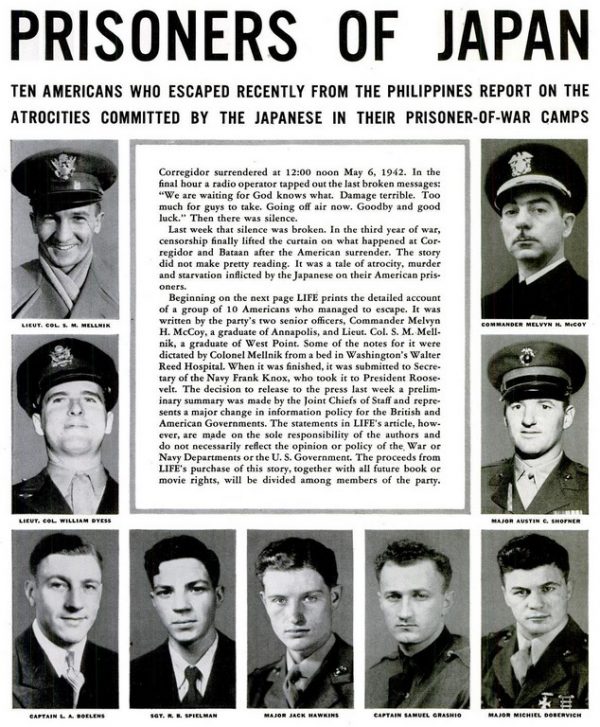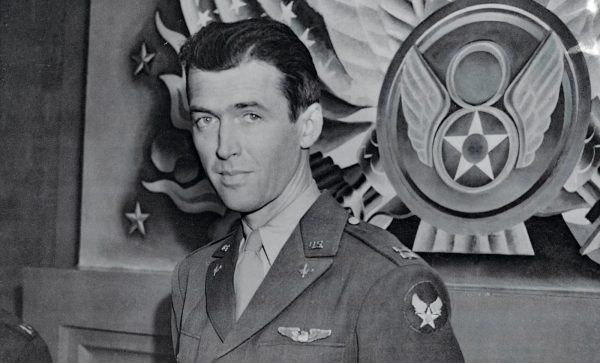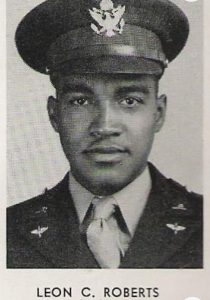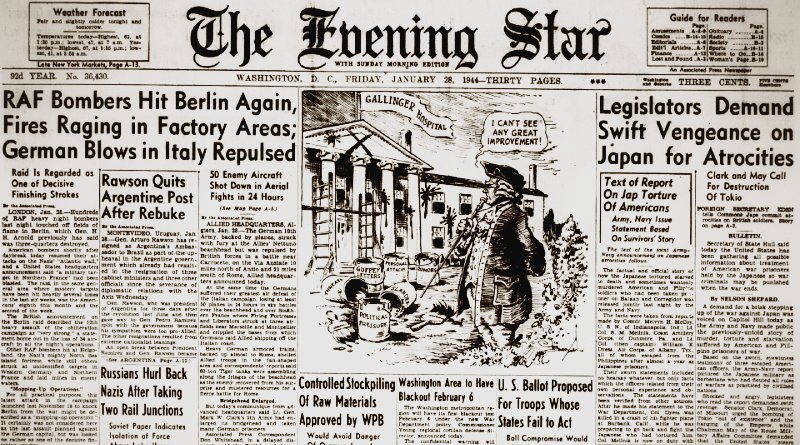World War II Chronicle: January 28, 1944
Click here for TODAY’S NEWSPAPER
On the front page we learn that Americans are discovering the barbaric treatment American prisoners of war are enduring while in Japanese captivity. Several men escaped from a facility in the southern Philippines after their capture at Corregidor in early 1942. Cmdr. Melvyn H. McCoy, Lt. Col. Stephen M. Mellnik, and Lt. Col. William E. Dyess are three of the survivors and are featured in a joint Army-Navy statement on Japanese torture.
McCoy (U.S. Naval Academy, Class of ’27), Mellnik (U.S. Military Academy, Class of ’35), and Dyess earned the Distinguished Service Cross. This was Dyess’ second DSC, and he is the namesake of Dyess Air Force Base in Abilene, Texas. Seven other Americans escaped the Davao Penal Camp, in what was the only mass escape of a Japanese POW camp during the war. Others include:
- Maj. Jack Hawkins (USNA, Class of ’32) — landed at Inchon and recaptured Seoul during the Korean War
- Maj. Austin C. Shofner
- 2nd Lt. Samuel C. Grashio
- Sgt. Paul H. Marshall — finished the war as a lieutenant colonel
- Maj. Michiel O. Dobervich
- Sgt. Robert B. Spielman
- 2nd Lt. Leo A. Boelens — killed on Jan. 22, 1944

Available records indicate nearly all recived the DSC, and many have at least one Silver Star for other actions during the Philippine campaign. They linked up with Col. Wendell Fertig’s guerillas and fought the Japanese for several months. American submarines eventually extracted them, three at a time…
Tom Harmon is pictured on page two, finally making it home after serving two years overseas… Hollywood icon, and now B-24 Liberator pilot and the 703rd Bombardment Squadron’s commander, Capt. Jimmy Stewart has been refusing to take a promotion to major until his junior officers also receive their promotions. Well on page two we see that whatever the holdup was, the brass has managed to swing promotions for Stewart’s men and he will soon be a major…

George Fielding Eliot column on page six… The Eighth Air Force is two years old today and reports that they have dropped 46,840 tons of bombs on Axis targets. That’s over 93 million pounds of bombs. That would require 23,420 bombers carrying a load of 4,000 lbs… Sports on page 10, which says that Casey Stengel is out a manager of the Boston Braves. The Old Perfessor will return to a dugout in 1949, leading the New York Yankees to seven World Series titles (five straight) in his 12-year stint… Future hall of famer George Kell is also pictured on page 10, who will return to the Philadelphia A’s this spring. Kell appeared in one game last year for Connie Mack, hitting a triple in his first at-bat…

On page 12 the Tuskegee Airmen of the 99th Fighter Squadron are reported to have shot down eight German fighters yesterday. Quoted is Capt. Leon C. “Derailer” Roberts, one of the first Tuskegee Airmen engaged in aerial combat. Roberts will be named operations officer, but is killed when his P-51 Mustang crashes after flying 97 combat missions. His twin brother Cleon was the unit’s instrument instructor…
Roving Reporter by Ernie Pyle
IN ITALY — I’m sure the most interesting thing around an American airdrome in Italy these days is the “rubbing out” process of the last few missions a combat airman goes on before he reaches that final one and returns to America.
It interest not only the man himself but everybody on the field from cook to crew chief. When a pilot gets within five missions of the finish everybody knows and watches his total. If one plane is missing when the group gets back, the first thing on everybody’s mind is wonderment over whether or not it’s the guy who is about finished.
Most squadron leaders deliberately pick what are expected to be easy missions for the pilot “getting it” on their last flight that the leaders are as nervous about it as the pilots.
In some outfits pilots go home automatically after a certain number of missions. In others they go only if the flight surgeon thinks they are too battle-worn or nervous to continue for another ten or so. I have yet to hear of a pilot who asked to fly beyond his allotted missions, although I am not saying there haven’t’ been such a case.
When a pilot comes back from his lat trip he turns out information as he nears the field and comes down wide open and screaming to “buzz” the field just above the ground. It is a gesture of elation similar to that of a fighter pilot doing a snap roll over the home field after shooting down a Nazi plane.
The pilots do all kinds of things after they finish. A friend of mine — Capt. Dean Schulyer of Jamaica, L.I., felt so good the night he got down that he canceled a $300 debt another pilot owed him.
Another one who finished the same day — Lieut. Swithin Shortlidge of West Grove, Pa. — shaved off the beard he had been growing for months.
Last fall Lieut. Shortlidge fell down and knocked out his upper front teeth and cut his chin. He started the beard then because he couldn’t shave for a while, and he finally decided to keep it until he had finished his missions.
The dentist made him a false plate to cover up the gaping hole in his mouth, but he refuses to wear it. With a long beard and a big grin and no teeth he was a sight to behold.
Lieut. Jimmy Griswold of Maywood, Cal., finished his missions while I was on the field. I asked him if his last one was the hardest. He said:
“No, it was all right one he got in the air, but thinking about it ahead of time almost had me in the asylum.”
We were sitting around the mess hall table, and Dean Schulyer said:
“Yes, we thought it was going to be very romantic. And it was, for the first few missions when everything was new and strange and you were just learning. But since then it’s been a job to do, just a job of muddy, hard work.” And all the others agreed.
Most dive-bomber pilots go home without any enemy planes to their credit, for attacking enemy planes isn’t their job. Jimmy Griswold says the first thing his younger brother is going to ask him is how many planes he shot down, and when he says “None at all” his brother is going to look at him awfully funny.
Some pilots finish and get home in as little as five months, while others are overseas more than a year before getting in their missions. Occasionally sickness or wounds will keep one out of the air for weeks, and he falls behind.
There is one hard-luck pilot — an excellent one too — who was laid up a long time with a bad flak wound in the leg. The just after he started flying again the jeep he was riding in was strafed by an enemy fighter and he went back to the hospital with another bad leg wound.
As a result, he is far behind on his mission and is just now starting in again while all his pals have gone home.
The saddest thing about the strafing was that the pilot who was driving the jeep had just finished his last mission and had his orders home — and he was killed.
Evening star. (Washington, D.C.), 28 January 1944. Chronicling America: Historic American Newspapers. Lib. of Congress.
https://chroniclingamerica.loc.gov/lccn/sn83045462/1944-01-28/ed-1/
